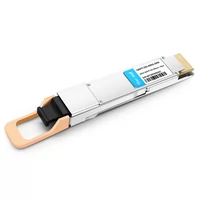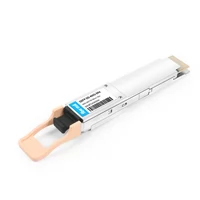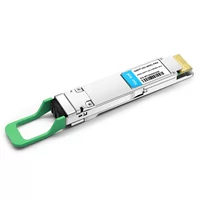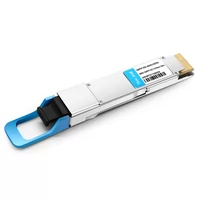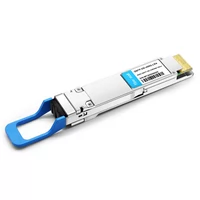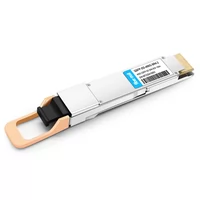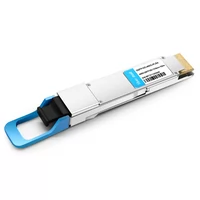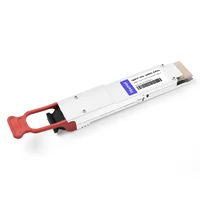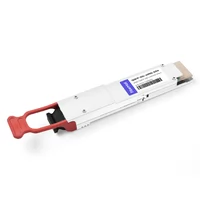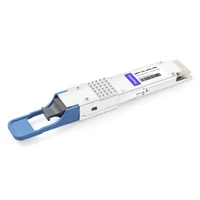In the high-speed networking world, everything is constantly changing. People want faster connections with lower delays, so this has caused people to make transceivers that are much better than they used to be. The QSFP56-DD (Quad Small Form-factor Pluggable Double Density) transceiver module is one example of a 400G network solution that represents significant advancement. This article will explore its technical specifications, benefits, limitations, and other transceiver modules available today. By doing so, readers should be able to understand where it stands with other similar products, thus enabling them to make the right decisions while setting up high-capacity networks.
Table of Contents
ToggleWhat is QSFP-DD, and How Does it Differ from QSFP56?
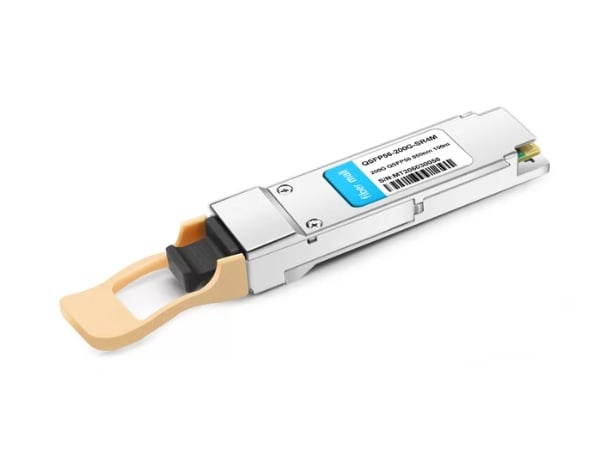
Understanding QSFP56-DD: Key Features and Benefits
The QSFP56-DD transceiver module is made in high-density networking environments for better performance. Among its features is supporting 400G data rates via a density configuration that allows transmitting over eight lanes—each operating at 50 Gbps. This design widens the bandwidth and simultaneously shrinks space needs within data centers. Moreover, They are also compatible with other modules of this type. They can be integrated into existing network infrastructures seamlessly which makes backward compatibility possible with current QSFP-DD applications too. With advanced thermal management technologies used in these devices, greater power efficiency and operational reliability are achieved. Generally speaking, the QSFP56-DD represents an important step ahead for transceiver technology because it meets growing demands for faster speeds, higher densities, and better efficiencies in modern network deployments.
Comparing QSFP-DD with QSFP56: What’s the Difference?
Architectural configuration and data transmission capacity are the main differentiators between QSFP56 and QSFP-DD. But bandwidth is not the same. QSFP56 uses four lanes, each capable of 50 Gbps, to achieve a data rate of 200G, while its successor achieves double that rate through eight enhanced lanes. The increased number of channels does more than just increase available bandwidth; it saves greatly on space and power, especially in environments with many connections packed into small areas. On top of these, thermal management has been made better in QSFP-DD, as well as other features that improve signal integrity, thereby making it more suitable for high-performance networks within modern infrastructures, which need higher efficiency, too.
Applications of QSFP56-DD in Data Centers
The QSFP56-DD transceiver is very useful for many different applications in data centers. With its 400G high data rate, it is the best choice for backbone network connections, which help to switch data efficiently between core networking architecture switches and routers. Furthermore, this device is extensively used in high-performance computing (HPC) clusters, where there is a need for high-speed processing and the transfer of large amounts of information. This transceiver allows for better scalability and allocation of bandwidth, thereby enabling data centers to handle heavy workloads like big data analytics, artificial intelligence, or cloud computing services, among others. Moreover, with its ability to work with current infrastructures, upgrades are made easier so that establishments can keep pace with changing technological demands without having to complete overhauls. Therefore, QSFP56DD significantly contributes towards improved effectiveness and efficiency levels within contemporary operations of data centers.
How Does QSFP-DD Compare to Other Transceiver Modules like QSFP28 and OSFP?
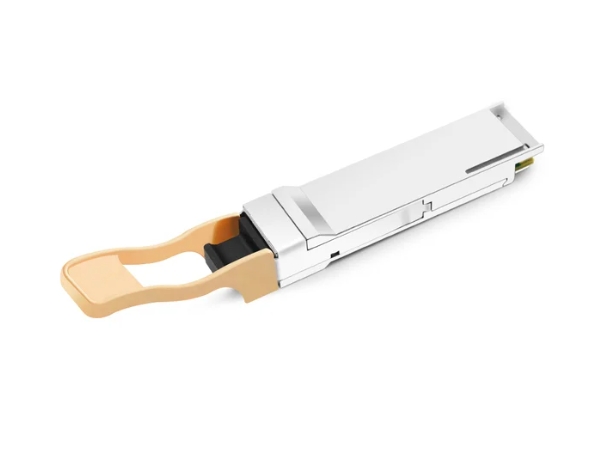
QSFP-DD vs. QSFP28: Which One Should You Use?
When it comes to settling between QSFP-DD and QSFP28 transceivers, there are a few things that need to be considered as well. In the box of 100g QSFP28, which is perfect for some traditional network applications but may not work as well in future-ready environments with ever-growing data needs, while on the other hand, 400G QSFP-DD provides much higher capacity that can keep up with bandwidth-hungry requirements and enhance the overall efficiency of networks. Additionally, these modules also have backward compatibility with existing QSFP28 applications; hence, they allow smooth migration without requiring too many infrastructure changes. Therefore, even though it serves best for now’s commonly recognized applications, if any organization expects a heavy increase in its transmission rates over time, then qsfp-dd will ensure better network performance. Ultimately, what type of transceiver one should purchase depends upon individual operational requirements, anticipated growth rates, plus financial restrictions.
QSFP-DD vs. OSFP: Differences in Form Factor and Performance
When you see a QSFP-DD and OSFP transceiver side by side, it’s clear that there are several differences between them in terms of form factor and performance. The Quad Small Form-factor Pluggable Double Density (QSFP-DD) is created as a compact solution that allows for more ports to be placed on the same switch or router without sacrificing any performance. It is compatible with QSFP28, which means that data centers can use their existing infrastructure to take advantage of higher data rates up to 400Gbps while still being able to work with previous versions.
On the other hand, because each lane supports 25Gbps and has eight lanes, Octal Small Form-factor Pluggable (OSFP) is bigger compared to QSFP-DD, thus giving a maximum aggregate capacity of 400 Gbps. In addition, its larger size enables better heat dissipation, therefore making it suitable for high-power applications where efficient cooling is required.
Although they both can support 400 Gigabit Ethernet applications, when should one choose between these two types? In situations where space is limited, people may prefer using QSFP-DD over OSFP or vice versa, depending on what power management capabilities are needed alongside thermal performance, among other things.
Compatibility of QSFP-DD with Other Transceivers
The QSFP-DD transceiver is made with the idea of being able to work with previous versions so that it can be smoothly incorporated into existing network infrastructures. It can be used together with the earlier QSFP28 transceiver modules because they are compatible, which means that people do not have to change their switches or routers when upgrading them. This feature is important for data centers that want to increase their bandwidths without spending much money.
Moreover, different types of optical and electrical modules are supported by the QSFP-DD, including those designed for multi-mode and single-mode applications. Hence, operators have more options on where they can deploy this technology depending on their needs and also use existing cables as well as connectors to exploit resources fully. Besides, any network system that uses QSFP-DD can accommodate several protocols plus data rates, thus making it versatile enough to keep up with changing technology standards while ensuring that network investments are future-proof.
What are the Technical Specifications of QSFP56-DD?
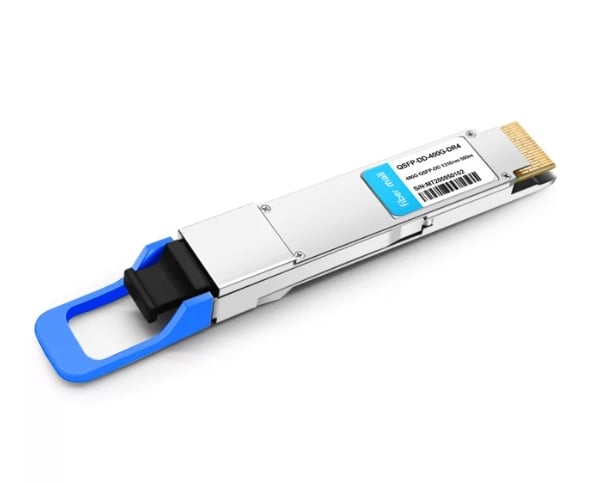
Data Rate and Performance of QSFP56-DD
When all four channels are used, the QSFP56-DD transceiver can provide a data rate of 56Gbps per channel thus giving a total aggregate bandwidth of 400Gbps. To achieve this higher data rate, more advanced modulation methods are employed together with better signal integrity that can be suitable for use in large-capacity data center interconnects and 5G applications. It also features improved thermal performance and lower power consumption than its predecessors while supporting various transport protocols such as Ethernet, Fibre Channel, and InfiniBand, ensuring flexibility across different networking environments. Therefore, this high-speed compatibility makes it an essential element for any contemporary network architecture.
Connector Types Used in QSFP56-DD Modules
QSFP56-DD modules use different connector types for fast data transfer. Standard connectors include the MPO (Multi-fiber push-on) connector, which is the most popular one for multi-mode fiber applications. This enables a higher frequency of connections within data centers without wasting space. Smaller LC (Lucent Connector) types can be adopted for single-mode applications while ensuring weak signals do not fall off over longer distances. Moreover, QSFP56-DD has backward compatibility with earlier versions of itself to work better across existing networks that are built using different formats. Among other things, these connectors guarantee the flexibility and reliability of QSFP56-DD modules under various modern networking environments where they can be applied.
PAM4 Modulation in QSFP56-DD: What You Need to Know
To QSFP56-DD modules, PAM4 (Four-level Pulse Amplitude Modulation) is a vital technology for driving faster data rates through the same optical infrastructure. In PAM4, unlike NRZ (Non-Return-to-Zero), which represents each bit as one voltage level, two bits are represented by four different levels of amplitude per symbol. This efficiency enhancement doubles the bandwidth utilization without taking more frequencies, thus enabling high-speed applications like those found in 5G networks or between data center interconnections.
Additionally, signal processing techniques with intense noise and signal integrity capability must be employed when implementing PAM4 modulation on QSFP56-DD modules since this supports performance at longer distances. For this reason, error correction and equalization algorithms are highly sophisticated in most equipment that supports PAM4. Generally, it can be said that through these signals, we can communicate more data over larger distances, so making optical communication systems better equipped for such tasks with respect to their capacities may require them, hence making modern networks heavily rely on QSFP56-DD modules as building blocks.
What are the Benefits of Using 400G QSFP56-DD Transceivers?
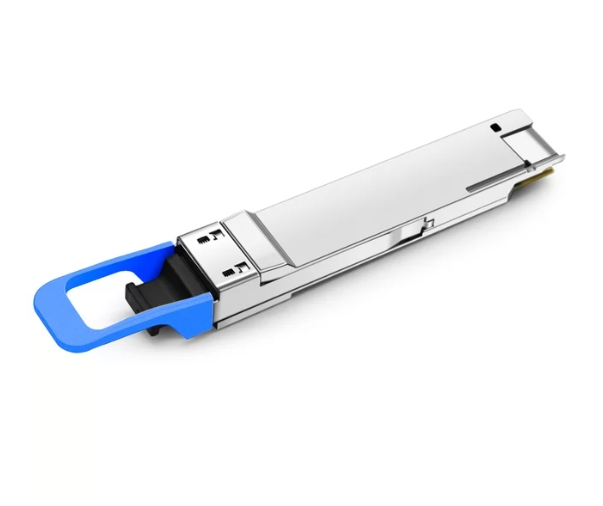
Advantages of 400G QSFP56-DD in High-Speed Networks
400G QSFP56-DD transceivers are a must-have in high-speed networking environments for several reasons. First, they can handle higher data rates of up to 400 Gbps, which meets the needs of cloud computing, data center interconnections, and 5G communications. As such, more information can be transmitted between systems faster without having to install additional infrastructure.
Two, QSFP56-DD modules are backward compatible with current networks having 100G and 200G modules, thus enabling smooth integration without requiring massive changes at once as organizations grow their network capabilities stepwise.
Third, the signal integrity has been improved while power consumed is reduced, which makes these devices sustainable for future-proofing designs of networks. This means that even in harsher conditions where performance would normally drop drastically due to heat generated through PAM4 modulation, among other advanced features, reliability and efficiency needed by modern high-speed networks are still achieved thanks to effective thermal management implemented in them.
Power Consumption and Efficiency of QSFP56-DD
The efficiency and overall impact of network infrastructure are significantly affected by the power consumption of 400G QSFP56-DD transceivers. They have been designed with better energy efficiency than previous versions. Generally, such transceivers consume between 6 and 8 watts on average, depending on models and applications – this is much lower than what would be required if multiple lower-speed transceivers were used to achieve the same data rates.
Also, among other things that can increase throughput capacity, PAM4 modulation technology integration into these devices helps save power, too. When less power is needed for transmission, establishments can lower operational expenditures while reducing environmental pollution. Moreover, effective thermal management capabilities adopted in QSFP56-DD designs not only ensure steady performance but also prevent the wastage of electrical energy by keeping temperatures within recommended ranges during operations. This emphasis on minimum power usage and maximum effectiveness has made them suitable for sustainable large-scale networking solutions.
How 400G QSFP56-DD Enhances Data Center Performance
The deployment of transceivers using 400G QSFP56-DD significantly improves data center performance through increased bandwidth and resource optimization. These transceivers allow for faster data transfers and reduced latency by enabling higher throughput rates, which are essential for supporting modern applications such as cloud computing, artificial intelligence, and big data analytics. Furthermore, the compact design of QSFP56-DDs facilitates high-density configurations that maximize space utilization in data centers while minimizing cable clutter.
In addition, advanced signaling technologies like PAM4 modulation ensure more efficient data transmission over existing infrastructure without requiring extensive upgrades. This capability enables data centers to scale their operations better, thus enhancing overall flexibility and responsiveness to changing bandwidth needs. These considerations create an environment within a data center where workloads can grow without compromising performance or reliability.
How to Ensure Compatibility and Integration of QSFP56-DD in Existing Systems?
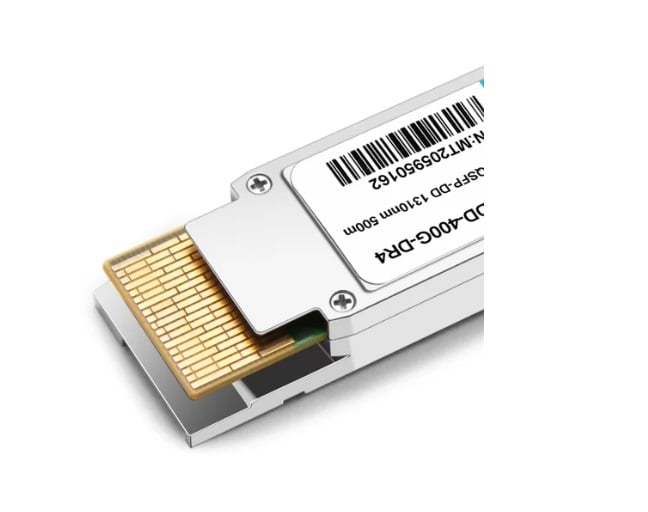
Backward Compatibility of QSFP56-DD Modules
The QSFP56-DD transceiver is designed to be backward compatible, so it can work with older versions of the module in existing systems. These systems include both QSFP28 and QSFP+. This means that network operators do not have to overhaul their whole system but can upgrade their infrastructure gradually. With the QSFP56-DD transceivers, one can still use 100G and 40G network configurations, which allow for an easy move to higher capacity and better performance optimization. Also, these modules are designed in a way that they have multi-rate capabilities thus enabling flexible connectivity options; this enables connection with devices operating at different speeds while maintaining efficient communication paths within the network. Such an adaptive feature enhances long-term investments in networks, making them sustainable over time as it enables organizations to respond quickly to changing data needs.
Integration with Existing QSFP Systems
A systematic method must be used to make sure that QSFP56-DD modules work well with present QSFP systems. One of the primary factors to consider is the physical and electrical interface; while providing higher data speeds, these elements have the same shape as their predecessors, which makes them easily installable into any existing QSFP ports. The first thing you need to do when integrating them, according to most reputable sources, is to check if your current network device firmware supports this kind of functionality because it may affect interoperability greatly.
Additionally, it is important to utilize optical transceivers that comply with recent industry standards like IEEE 802.3bs since they help increase performance while reducing latency. This involves testing all hardware and software components rigorously during the integration phase so as to unearth compatibility challenges early enough. Besides, a phased deployment strategy can be adopted where managers slowly introduce advanced modules into their networks, thus minimizing chances for disruption while making sure that such transitions don’t compromise the strength or efficiency of the system at any given time. Such meticulousness improves dependability and prepares one for future growth in data needs, which may call for scalability within the infrastructure itself.
Configuration Tips for Seamless Operation
To ensure seamless operation while integrating QSFP56-DD modules, proper configuration is necessary. First of all, make sure you update all your network devices with the latest firmware, which supports not only QSFP56-DD but also enhances performance and security. Configure link aggregation settings following vendor documentation and industry best practices that allow several connections to work as one logical link thus increasing bandwidth and resilience.
Another thing that needs to be done is setting up optical monitoring capabilities to monitor link health and performance metrics, which will help in proactive maintenance. Some parameters, such as the Minimum and Maximum TX power, may also need to be adjusted to reduce signal degradation and optimize transmission over long distances.
Additionally, it may involve using comprehensive monitoring tools to assess network performance after integration, hence providing visibility into potential issues that can then be addressed promptly to ensure the system’s smooth running. These should always be reviewed regularly based on changing demands within the network so that continuous optimization can be achieved alongside reliability.
Reference Sources
Frequently Asked Questions (FAQs)
Q: What is the difference between other transceiver modules and QSFP56-DD?
A: Compared to other QSFP modules, QSFP56-DD is an advanced optical transceiver module that offers double-density (DD) capabilities. It supports 400G Ethernet, which provides higher data rates and better efficiency. These modules comply with the QSFP-DD MSA standard and have an extended electrical interface and form factor for improved performance.
Q: How does QSFP-DD compare with QSFP56?
A: There are significant improvements in QSFP-DD, Quad Small Form-factor Pluggable Double Density, over QSFP56. While QSFP56 typically supports up to 200G, QSFP-DD modules support 400G Ethernet. The higher port density and bandwidth are available with the QSFP-DD form factor. Also, different modulation schemes like PAM4 can be used by QSFP-DD transceivers, while NRZ modulation is commonly used in those of QSFP56.
Q: What are some benefits of utilizing this technology?
A: Some of the advantages provided by this technology include compatibility with existing interfaces through backward compatibility while supporting 400G Ethernet; increased data throughput; double density (DD) design, which allows for a higher number of ports; versatility where they can operate at different wavelengths or distances hence suitable for various networking applications.
Q: How does the form factor of qsfp-dd differ from qsfp28?
A: Compared to supporting 100G for qsfp28 modules, the form factor of qsfp-dd supports 400G, four times denser than its counterpart qsfp28. The design of qsfp-dd includes an extended electrical interface to accommodate higher data rates and backward compatibility, making it more versatile for data center applications.
Q: Can I use qsfp-dd transceivers in my legacy systems?
A: They can be used in legacy systems because they are backward compatible with QSFP interfaces such as QSFP28 and QSFP56. This means you can easily integrate them into your existing data center infrastructure without making any major changes.
Q: What are the optical technologies used in QSFP-DD modules?
A: QSFP-DD modules use PAM4 modulation and multiple optical wavelengths to increase bandwidth efficiency for fast data transmission. Standard optics in QSFP-DD include DR4, which supports a 500m distance, and FR4, which can reach 2km over single-mode fibers with duplex LC connectors.
Q: What are some typical applications of 400G QSFP-DD transceivers?
A: These devices can serve applications that require high bandwidth, low latency, and scalable network solutions, such as data center interconnects, high-performance computing networks, enterprise core networks, and service provider backbones.
Q: How does the QSFP-DD MSA impact the development and deployment of QSFP-DD modules?
A: The Multi-Source Agreement (MSA) for QSFP-DD sets out rules for creating or using different transceivers based on this technology. It establishes specifications such as electrical interface standards, mechanical dimensions, etc., so manufacturers can make compatible products, thus fostering wider adoption and innovation within the sector.
Q: What distinguishes QSFP-DD from other 400G transceiver form factors like OSFP or COBO?
A: These three types have many differences, namely size density performance, etc. For instance, OSFP is more extensive concerning size than both COBO and QSFP-D+D, offering higher power dissipation and better thermal capabilities while still maintaining compatibility since it uses a similar architecture. COBO has been explicitly designed for onboard integration, making it even more compact than QSFDD or OSFPP.
Related Products:
-
 QSFP-DD-400G-SR8 400G QSFP-DD SR8 PAM4 850nm 100m MTP/MPO OM3 FEC Optical Transceiver Module
$149.00
QSFP-DD-400G-SR8 400G QSFP-DD SR8 PAM4 850nm 100m MTP/MPO OM3 FEC Optical Transceiver Module
$149.00
-
 QSFP-DD-400G-SR4 QSFP-DD 400G SR4 PAM4 850nm 100m MTP/MPO-12 OM4 FEC Optical Transceiver Module
$450.00
QSFP-DD-400G-SR4 QSFP-DD 400G SR4 PAM4 850nm 100m MTP/MPO-12 OM4 FEC Optical Transceiver Module
$450.00
-
 QSFP-DD-400G-FR4 400G QSFP-DD FR4 PAM4 CWDM4 2km LC SMF FEC Optical Transceiver Module
$500.00
QSFP-DD-400G-FR4 400G QSFP-DD FR4 PAM4 CWDM4 2km LC SMF FEC Optical Transceiver Module
$500.00
-
 QSFP-DD-400G-XDR4 400G QSFP-DD XDR4 PAM4 1310nm 2km MTP/MPO-12 SMF FEC Optical Transceiver Module
$580.00
QSFP-DD-400G-XDR4 400G QSFP-DD XDR4 PAM4 1310nm 2km MTP/MPO-12 SMF FEC Optical Transceiver Module
$580.00
-
 QSFP-DD-400G-LR4 400G QSFP-DD LR4 PAM4 CWDM4 10km LC SMF FEC Optical Transceiver Module
$600.00
QSFP-DD-400G-LR4 400G QSFP-DD LR4 PAM4 CWDM4 10km LC SMF FEC Optical Transceiver Module
$600.00
-
 QSFP-DD-400G-SR4.2 400Gb/s QSFP-DD SR4 BiDi PAM4 850nm/910nm 100m/150m OM4/OM5 MMF MPO-12 FEC Optical Transceiver Module
$900.00
QSFP-DD-400G-SR4.2 400Gb/s QSFP-DD SR4 BiDi PAM4 850nm/910nm 100m/150m OM4/OM5 MMF MPO-12 FEC Optical Transceiver Module
$900.00
-
 QSFP-DD-400G-PLR4 400G QSFP-DD PLR4 PAM4 1310nm 10km MTP/MPO-12 SMF FEC Optical Transceiver Module
$1000.00
QSFP-DD-400G-PLR4 400G QSFP-DD PLR4 PAM4 1310nm 10km MTP/MPO-12 SMF FEC Optical Transceiver Module
$1000.00
-
 QSFP-DD-400G-ER4L 400G QSFP-DD ER4 Lite 30km LWDM4 LC SMF with FEC Optical Transceiver Module
$3000.00
QSFP-DD-400G-ER4L 400G QSFP-DD ER4 Lite 30km LWDM4 LC SMF with FEC Optical Transceiver Module
$3000.00
-
 QSFP-DD-400G-ER4 400G QSFP-DD ER4 PAM4 LWDM4 40km LC SMF without FEC Optical Transceiver Module
$3500.00
QSFP-DD-400G-ER4 400G QSFP-DD ER4 PAM4 LWDM4 40km LC SMF without FEC Optical Transceiver Module
$3500.00
-
 QSFP-DD-400G-DR4 400G QSFP-DD DR4 PAM4 1310nm 500m MTP/MPO SMF FEC Optical Transceiver Module
$400.00
QSFP-DD-400G-DR4 400G QSFP-DD DR4 PAM4 1310nm 500m MTP/MPO SMF FEC Optical Transceiver Module
$400.00

